from:
-- Dr. Peter J. D'Adamo / Catherine Whitney: 4
Blutgruppen. Vier Strategien für ein gesundes Leben. Mit
Rezeptteil (Piper 2001) (orig. English: 4 Blood Types, 4
Programs. Live Right 4 Your Type)
-- Peter D'Adamo: 4 Blutgruppen - richtig leben. Das
individuelle Konzept für körperliches und seelisches
Wohlbefinden (Piper 2002) (orig. English: 4 Blood Types, 4
Diets. Eat Right 4 Your Type)
Chronology
1930s
First blood group research in the 1930s
Prof. Takeji Furukawa is publishing articles about first
blood group research, also in the German "Review for applied
psychology" ("Zeitschrift für angewandte Psychologie".
(richtig leben, p.37)
since 1957
Father James D'Adamo begins with empiric blood group
research
(4 Strategien, p.12)
Father James D'Adamo is observing 1,000s of patients how
they are behaving and is parting them into blood groups
(richtig leben, p.37).
Peter D'Adamo describes the work of his father James like
this:
"In 1957 my father Dr. James D'Adamo finished his education
(4 Strategien, p.12) ad College for natural healing (this
had been an additional study of four years). Then he
continued his studies in some known health resorts in
Europe. During this time he found out the striking fact that
many patients were going to be healthy with a strict
vegetarian diet which was also poor of fat - this was the
typical characteristic of the kitchen of sanatoriums. But
many [other patients] did not get better with it. Some
persons had no bettering of their troubles with this food,
but their general state was even worsening.
My father, a sensible man with a sharp capacity for abstract
analysis and with a great capacity of special knowledge, he
came to the conclusion that there had to be some kind of
list with the products on it with which the one or the other
group of humans would feel and getting well with it. His
argumentation was: When blood is a base for food of the
organism, then some aspect of the blood can contribute to
the termination of these differences.
That's why he began to verify his theory. He determined the
particular blood group of his patients and could watch their
reaction when the were given different diets. When he had
treated many patients within many years he could find out a
certain basic pattern which person would gain health with
which food.>
(orig. German:
"1957 schloss mein Vater Dr. James D'Adamo seine
Ausbildung an (4 Strategien, S.12) einem College für
Naturheilkunde ab (ein vierjähriger zusätzlicher
Studiengang). Im Anschluss daran setzte er seine Studien
in einigen bekannten Kurorten in Europa fort. Dabei fiel
ihm auf, dass vielen Patienten eine streng vegetarische
und fettarme Kost - die typischen Kennzeichen der Küche
von Sanatorien - gut bekam, sich jedoch bei etlichen
[anderen Patienten und Patientinnen] keinerlei Anzeichen
einer Besserung erkennen liessen. Die Diät verschaffte
manchen Personen keine Linderung ihrer Beschwerden,
sondern verschlechterte vielmehr den Allgemeinzustand.
Mein Vater, ein sensibler Mann, der über ein scharfes
Abstraktionsvermögen und grosse Fachkenntnisse verfügte,
kam zu dem Schluss, dass es irgendeine Art Blaupause geben
müsse, anhand deren sich die verschiedenen
Ernährungsbedürfnisse der Patienten bestimmen liessen.
Seine Argumentation lautete: Da Blut die grundlegende
Nahrungsquelle des Organismus darstellt, muss irgendein
Aspekt des Blutes einen Beitrag zur Bestimmung dieser
Unterschiede leisten.
Deshalb begann er, seine Theorie zu überprüfen: Er
bestimmte die jeweilige Blutgruppe seiner Patienten und
beobachtet ihre Reaktionen, wenn man ihnen
unterschiedliche Diäten verordnete. Nachdem er im Laufe
der Jahre unzählige Patienten behandelt hatte, zeichnete
sich allmählich ein bestimmtes Grundmuster ab.>
<
Blood group A: It was striking that patients of
blood group A were not going well with a diet rich of
proteins, rich of meat, but were going very well with a diet
with vegetarian protein containing soya and tofu. With these
persons of type A milk products provoked normally more
segregation of mucosa in the sinus and in the airways. When
they were suggested to move more with more sports they
mostly were exhausted and did not feel well; but when they
elected the lighter form of moving for example with yoga,
then they felt fresh and full of energy.
Blood group 0: To the contrary patients with blood group 0
went well with much proteins of animals, and they felt
reinvigorated by bodily activities like jogging and aerobic.
The more my father was testing the patients according to the
blood groups, the more grew the conviction in him that every
patient had an individual way for getting back his physical
health.> (4 Strategien, p.13)
(orig. German:
Blutgruppe A: Ihm
fiel auf, dass Patienten mit der Blutgruppe A eine
eiweissreiche Kost, die reichlich Fleisch enthielt,
schlecht bekam, es ihnen jedoch bei einer Diät, die
pflanzliches Eiweiss wie Soja und Tofu enthielt, sehr gut
ging. Bei diesen Personen führten Milchprodukte in der
Regel zu einer reichlichen Schleimhautabsonderung in den
Nebenhöhlen und Atemwegen. Empfahl man ihnen, sich mehr
körperlich zu betätigen, waren sie meist erschöpft und
unwohl; wenn sie leichtere Formen der körperlichen
Betätigung wählten, beispielsweise Yoga, so fühlten sie
sich frisch und energiegeladen.
Blutgruppe 0:
Andererseits ging es Patienten mit der Blutgruppe 0, die
eine Kost mit viel tierischem Eiweiss zu sich nahmen, sehr
gut; sie fühlten sich durch körperliche Betätigung wie
Jogging und Aerobic gestärkt.
Je mehr mein Vater die Träger der einzelnen Blutgruppen
testete, desto mehr wuchs seine Überzeugung, dass jeder
Patient einem individuellen Weg zu physischem Wohlbefinden
folgte." (4 Strategien, S.13)
Father James D'Adamo recognizing different schemes
for overcoming stress according to blood groups
Peter D'Adamo:
<In the last 35 years my father had studied the typical
reaction patterns and the energy with the familiar members
of the different blood groups. He developed then training
programs specific to the blood groups for moving the body
which came out by the biological profile of the different
types.
After having analyzed thousands of patients, adult persons
as children, this empiric research got it's final shape.
His results indicate a striking conformity with the
cognition we have about the successful managing of some
types of metabolism with mental and bodily charges.
Above all within the studies of my father the following
aspect was revolutionary (p.66-67): Different types need for
overcoming of their stress reaction their special sports
program.> (4 Strategien, p.67)
(orig. German:
"Mein Vater hat die vergangenen 35 Jahre dem Studium der
typischen Reaktionsmuster und dem Mass an Energie bei den
Angehörigen der verschiedenen Blutgruppen gewidmet und
blutgruppenspezifische Trainingsprogramme zur körperlichen
Betätigung entwickelt, die sich aus dem biologischen
Profil der einzelnen Typen ergeben.
Nachdem er tausende Patienten, Erwachsene wie Kinder,
beobachtet hatte, haben diese empirischen Forschungen
schliesslich eine gültige Form angenommen.
Seine Ergebnisse weisen eine bemerkenswerte
Übereinstimmung mit den Erkenntnissen auf, die wir über
den erfolgreichen Umgang der einzelnen Stoffwechseltypen
mit seelischen und körperlichen Belastungen gewonnen
haben.
Besonders revolutionär war der Aspekt der (S.66) Studien
meines Vaters, wonach die verschiedenen Typen zur
Bewältigung ihrer Stressreaktionen ein besonderes
sportliches Programm brauchen." (4 Strategien, S.67).
1970s?
Mother dying with breast cancer - the energy of
Peter D'Adamo making research about breast cancer
The parents are divorced first, and when son Peter is living
with the mother which has roots in Spain in Catalonia, there
is cooked Mediterranean food with meat, salads and with
proceeded food, without blood group diet. The mother does
not accept the knowledge of the father [James D'Adamo] (4
Strategien, p.345). The children have to watch how her
mother is suffering a breast cancer, how she gets
chemotherapy, and how after some years she suffers a
recidivism and then dies. Then the children live with their
father. Son Peter is swearing to make a breast cancer
research (4 Strategien, p.346).
The words of Peter D'Adamo:
<Always when I am making research about the connection
between blood group of humans and cancer diseases, then I
have to think about my mother. My mother was a special
person in our family - she had blood group A and she was
eating what she liked. She had the notorious strong will of
the population of Catalonia, her home land. In her household
(my parents were divorced) a simple Mediterranean food was
served, with meat, salads and with some proceeded food.
Instead of the research work of my father about the
connection between blood groups and health there was far and
wide no soya bean, no legumes, as long as we lived with
mother.
Anybody who has seen how a family member or a friend was
fighting the fight against cancer and died at the end knows
that there is nothing hurting more in the heart. When I saw
how my mother got her first breast amputation, then
chemotherapy, then a short recovery and then a recidivism, I
saw the huge quantity of intruders practically before me
which were intruding also into the healthy cells of my
mother now and were preparing there their destructive work
before storming the immune system like barbarians by a
surprise attack. At the end they could not be stopped by
anything and got their victory.
In the years after the death of my mother I always returned
to the secret of cancer disease. I asked myself often again
and again if my mother had been preserved of the illness
when she had eaten a diet of blood group A, or if she had
been elected genetically for a fight and to loose it. I was
searching about this topic for finding a solution in her
name. One could say (p.345) that I was leading a kind of
revenge campaign not only against all cancer diseases, but
especially against breast cancer.> (4 Strategien, p.346)
(orig. German:
"Immer wenn ich den Zusammenhang untersuche, der zwischen
der Blutgruppe eines Menschen und Krebs besteht, muss ich
an meine Mutter denken. Meine Mutter stellte in unserer
Familie eine Besonderheit dar - sie hatte die Blutgruppe A
und ass, was ihr gefiel. Sie hatte den notorischen starken
Willen der Bewohner Kataloniens, ihrer Heimat. In ihrem
Haushalt (meine Eltern waren geschieden) wurde eine
schlichte Mittelmeerkost serviert, die aus Fleisch,
Salaten und einigen verarbeiteten Lebensmitteln bestand.
Trotz der Forschungsarbeit meines Vaters über den
Zusammenhang von Blutgruppenzugehörigkeit und Gesundheit
war weit und breit keine Sojabohne, keine Hülsenfrucht zu
sehen, solange wir Kinder bei der Mutter lebten.
Jeder, der miterlebt hat, wie ein Familienangehöriger oder
ein Freund einen tapferen, aber letztlich aussichtslosen
Kampf gegen den Krebs führt, weiss, dass es nichts
Herzzerreissenderes gibt. Als ich sah, wie meine Mutter
erst eine Brustamputation, dann eine Chemotherapie
durchmachte, die Krankheitserscheinungen kurz nachliessen
und es dann zu einem Rückfall kam, sah ich die Scharen
unsichtbarer Eindringlinge praktisch vor mir, die sich in
die gesunden Zellen meiner Mutter stahlen und sich dort
zusammenrotteten, ehe sie durch das Immunsystem stürmten
wie Barbaren bei einem Überraschungsangriff. Am Ende
liessen sie sich durch nichts stoppen. Sie trugen den Sieg
davon.
In den Jahren seit dem Tod meiner Mutter bin ich immer
wieder zu den Geheimnissen des Krebses zurückgekehrt. Ich
habe mich oft gefragt, ob meine Mutter von der Krankheit
verschont geblieben wäre, wenn sie eine A-Typ-Diät
gehalten hätte, oder ob sie aufgrund ihrer Gene dazu
auserwählt war, diesen Kampf auszufechten und zu
verlieren. Ich habe mich der Aufgabe gewidmet, in ihrem
Namen eine Antwort darauf zu finden. Man könnte sagen
(S.345), dass ich eine Art Rachefeldzug nicht nur gegen
alle Krebserkrankungen führe, sondern besonders gegen den
Brustkrebs." (4 Strategien, S.346)
1970s
Blood group research in Japan presented by Nomi
Journalist Masahiko Nomi and his son Toshitaka Nomi are
writing over 65 books about blood group research on the base
of empiric research and consequent observation about the
connection between blood group and character (richtig leben,
p.37).
1978: Foundation of Bastyr University for Natural
Medicine in Seattle
In 1978 Bastyr University for Natural Medicine in Seattle is
founded. Peter D'Adamo is beginning there his studies at
once (4 Strategien, p.375). Bastyr University under
headmaster Dr. Pizzorno is the "first stately recognized
multidisciplinary high school for natural medicine in the
USA". Dr. Pizzorno is establishing new standards with his
collected editions
-- "A Textbook of Natural Medicine"
-- "Encyclopedia of Natural Medicine" (4 Strategien, p.378).
Bastyr
University for Natural Medicine in Seattle
|

Bastyr University in Seattle, the main building
[1]
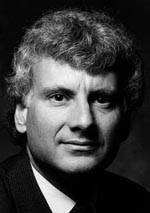
Joseph Pizzorno, portrait [3]
|

Bastyr University in Seattle, logo [4]
|
|

Bastyr University in Seattle, herb garden [2]
|
Book by James D'Adamo: "One Man's Food" - education
of son Peter D'Adamo at John Bastyr College in Seattle
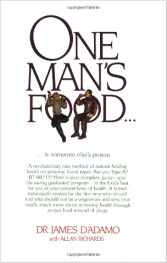 |
 The book of father James D'Adamo and Allan
Richards "One Man's Food" of 1980, cover [5]
The book of father James D'Adamo and Allan
Richards "One Man's Food" of 1980, cover [5]
orig. English:
<One Man's Food... or someone's else poison. A
revolutionary new method of natural healing
based on personal blood types. Are you Type A? B?
AB? 0? Here is your complete guide - and
life-saving graduated program - to the foods best
for you at your present level of health. A famed
naturopath reveals for the first time who should
and who should not be a vegetarian and why, plus
much, much more about achieving health through
proper food instead of drugs.> |
Father James D'Adamo is editing his first book in 1980
propagating blood group nutrition.
The words of Dr. Peter D'Adamo:
<According to the slogan "what is good for one, must not
be good for the other" he [father James D'Adamo] was
compiling his observations and diet recommendations in a
book with the title "One Man's Food". When the book was
edited in 1980, I was studying in the third year with
natural medicine at John Bastyr College in Seattle.
During this time there were striking successes with the
education of natural medicine. At Bastyr College there had
been put the aim to form the comprehensive well educated
nature doctor: a parallel to the specialist for Inner
Medicine, but with a special education in natural medicine.
For the first time methods, procedures and substances of
natural medicine were worked out with scientific and
technical methods getting precise results.> (4
Strategien, p.14)
(orig. German:
<Nach dem Motto "was für den einen gut ist, muss es für
den anderen noch lange nicht sein" fasste er [Vater James
D'Adamo] seine Beobachtungen und Ernährungsempfehlungen in
einem Buch mit dem Titel "One Man's Food" zusammen. Als
das Buch im Jahre 1980 erschien, studierte ich im dritten
Jahr Naturheilkunde am John-Bastyr-College in Seattle.
Während dieser Zeit wurden in der naturheilkundlichen
Ausbildung gerade umwälzende Erfolge erzielt. Am
Bastyr-College hatte man sich das Ziel gesetzt, den
umfassend gebildeten Naturheilmediziner auszubilden: ein
Pendant zum Facharzt für Innere Medizin, jedoch mit einer
speziellen Ausbildung in Naturmedizin. Zum ersten Mal
liessen sich die Methoden, Verfahren und Substanzen der
Naturheilmedizin auf wissenschaftlichem Wege mit
Unterstützung moderner medizinisch-technischer Verfahren
auswerten.> (4 Strategien, S.14)
Dr. Peter D'Adamo revising the blood group book of
his father James with the new methods
The words of Dr. Peter D'Adamo:
<I waited for the occasion to revise the blood group
theory of my father. I wanted to be convinced that his
theory was scientific enough for modern times of nowadays.
This possibility was given to me in 1982 when I was revising
medical professional literature for my final exam during the
last year of my studies. I wanted to find out if there is a
connection between the members of blood groups (A, B, AB, 0)
and the predisposition for certain diseases, and if my
results would support the nutrition doctrine of my father.
The data in my father's book was more or less with the base
of subjective impressions which he had won by the members of
the different blood groups, and less by an objective
analysis method, [and therefore] I was not sure if I would
succeed in finding out the scientific base for his theories.
But what I found out with this work was really amazing.>
(4 Strategien, p.14)
(orig. German:
<Ich wartete auf eine Gelegenheit, die
Blutgruppentheorie meines Vaters zu überprüfen. Ich wollte
mich davon überzeugen, dass sie den Anforderungen
wissenschaftlicher Erkenntnismethoden standhielt. Diese
Möglichkeit bot sich mir 1982, als ich für eine Prüfung im
letzten Jahr meiner klinischen Ausbildung die medizinische
Fachliteratur zu sichten begann. Dabei wollte ich
herausfinden, ob eine Korrelation zwischen der
Zugehörigkeit zu einer der Blutgruppen A, B, AB und 0 und
einer Disposition für bestimmte Erkrankungen bestand und
ob meine Ergebnisse die Ernährungslehre meines Vaters
stützten.
Da das Buch meines Vaters eher auf subjektiven Eindrücken
beruhte, die er von den Angehörigen der einzelnen
Blutgruppen gewonnen hatte, und weniger auf einer
objektiven Auswertungsmethode, war ich mir nicht sicher,
ob es mir gelingen würde, eine wissenschaftliche Grundlage
für seine theoretischen Überlegungen zu finden. Doch was
ich dabei herausfand, setzte mich in grosses
Erstaunen.> (4 Strategien, S.14)
After his final exam at Bastyr University for Natural
Medicine in 1982 (4 Strategien, p.375) Peter D'Adamo is
working in interdisciplinary research. Until 1989 he is
succeeding in combining "normal medicine" with natural
medicine in a scientific way (4 Strategien, p.377).
Dr. Peter D'Adamo
states scientificity of blood group research - blood
group nutrition - blood group diet
The words of Dr. Peter D'Adamo:
<The first innovative recognition came when I detected
that two real stomach diseases were with the same blood
group. One disease was a gastrointestinal ulceration. This
is a disease which often occurs with a higher level of
stomach acid. Professional literature showed that the
victims were more of blood group 0 than of other blood
groups. My interest was (Strategien, p.14) coming up at once
because my father had observed that patients of blood group
0 could live well with animal products and with food rich of
[animal] protein, which required a digestion with much
stomach acid (Strategien, p.15).
The second connection was the between blood group A and
stomach cancer. Stomach cancer was often shown occurring in
connection with a low level of stomach acid. the same counts
for the so called pernicious anemia, also a disease which
could found often with persons of this blood group.
Pernicious anemia often goes also with a shortage of vitamin
B12 which resorption requires a sufficient quantity of
stomach acid.
Studying these facts it became clear that at one side the
blood of group 0 was provoking a vulnerability for one
illness which was in connection with too much stomach acid,
and at the other side blood group A was responsible for two
other illnesses which were in connection with a low level of
stomach acid.
This was the connecting link I had been looking for. With
this there was with no doubt a scientific base for the
observations of my father. And in this way my passion for
scientific research of blood groups came up which exists
until today, and also the research for the anthropological
preconditions. In the course of time came out that the first
investigations of my father about the connections between
the blood groups, nutrition and health were very important,
more important than he had imagined himself.> (4
Strategien, p.15).
(orig. German:
<Die erste bahnbrechende Erkenntnis kam mir, als ich
entdeckte, dass zwei ernste Magenerkrankungen mit einer
bestimmten Blutgruppe in Zusammenhang standen. Bei der
einen [Krankheit] handelte es sich um das
Magen-Darm-Geschwür, ein Leiden, das oft mit einem
erhöhten Magensäurespiegel verbunden ist. Die
Fachliteratur zeigte, dass häufiger Personen mit der
Blutgruppe 0 als Personen der übrigen Blutgruppen daran
erkrankten. Mein Interesse war (S.14) sofort geweckt, da
mein Vater beobachtet hatte, dass Patienten mit der
Blutgruppe 0 Tierprodukte und eine [tierisch-]
eiweissreiche Kost gut vertrugen, also Lebensmittel, deren
Verdauung häufig in erhöhtem Masse Magensäure erfordert
(S.15).
Der zweite Zusammenhang war die Verbindung zwischen
Blutgruppe A und Magenkrebs. Magenkrebs wurde oft mit
einer geringen Magensäureproduktion in Verbindung
gebracht. Das gleiche gilt für die so genannte
verderbliche oder perniziöse Anämie, ebenfalls eine
Erkrankung, die man häufiger bei Personen mit dieser
Blutgruppe findet. Die perniziöse Anämie geht oft mit
einem Mangel an Vitamin B12 einher, dessen Resorption eine
ausreichende Menge an Magensäure erfordert.
Beim Studium dieser Tatsachen wurde mir klar, dass
einerseits das Blut der Gruppe 0 Menschen für eine
Krankheit anfällig machte, die mit zu viel Magensäure in
Verbindung steht, andererseits die Blutgruppe A Personen
für zwei Krankheiten prädisponierte, die mit zu wenig
Magensäure zusammenhingen.
Das war das Verbindungsglied, nach dem ich gesucht hatte.
Somit bestand zweifelsfrei eine wissenschaftliche Basis
für die Beobachtungen meines Vaters. Und so entstand meine
bis heute bestehende Leidenschaft für die
wissenschaftliche Erforschung der Blutgruppen und ihre
anthropologischen Voraussetzungen. Im Laufe der Zeit
stellte sich dann heraus, dass die ersten Untersuchungen
meines Vaters über die Zusammenhänge zwischen Blutgruppe,
Ernährung und Gesundheit weitaus bedeutender waren, als
selbst er es sich je vorgestellt hatte.> (4 Strategien,
S.15)
Peter D'Adamos breakthrough in 1989
In the innovating speech of 1989 at an annual meeting of
"American Association of Naturophatic Physicians" in
Rippling River (Oregon) D'Adamo is reaching his breakthrough
with the public (4 Strategien, p.377).
Since 1989 blood group diet of Dr. D'Adamo is applied in
many clinics in "USA" (4 Strategien, p.377).
1990s
Genetic research confirms a big part of blood group
nutrition of James D'Adamo
(richtig leben, p.37)
1994
Book of Peter Constantine about blood groups:
"What's Your Type"
There are many parallels with Nomi in Japan, but also
aberrations (richtig leben, p.37-38).
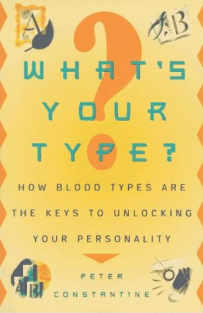 |
Book of Peter Constantine: "What's Your
Type? How blood types are the keys to unlocking
your personality". Plume edition, New York 1997
[6]
|
Family D'Adamo is blood group A - and it's nutrition
is against main stream "food"
The words of Dr. Peter D'Adamo:
<I was growing up in a family where most family members
were of blood group A. [After the death of his mother the
children were growing up with the father]. Because of the
father's profession we ate a mostly vegetarian alimentation
consisting of tofu, stewed vegetable, and salads (4
Strategien, p.15). As a child I was often embarrassed and I
had the impression that we were discriminated because no one
of my friends was eating something "strange" like tofu. To
the contrary: My friends had followed "nutrition revolution"
with a big joy which was occupying "USA" in the 1950s. Their
alimentation was composed of hamburgers, hot dogs, fat fried
potatoes, chocolate bars, ice cream and much lemonade.
Today I am alimenting myself like in during my childhood's
days, and it's taste is very well. Every day I take this
food to which is longing my body of blood group A. And this
is a really satisfying result.> (4 Strategien, p.16)
(orig. German:
<Ich wuchs in einer Familie auf, deren Angehörige
überwiegend die Blutgruppe A hatten. [Nach dem Tod der
Mutter wuchsen wir Kinder beim Vater auf]. Aufgrund der
beruflichen Tätigkeit meines Vaters assen wir eine im
wesentlichen vegetarische Kost, die aus Lebensmitteln wie
Tofu, gedünstetem Gemüse sowie Salaten (S.15) bestand. Als
Kind genierte ich mich häufig und kam mir benachteiligt
vor, weil keiner meiner Freunde so etwas "Komisches" wie
Tofu ass. Im Gegenteil: Meine Freunde hatten sich
mit grossem Vergnügen einer anderen "Ernährungsrevolution"
angeschlossen, die in den fünfziger Jahren die USA
eroberte: Ihre Ernährung setzte sich aus Hamburgern, Hot
Dogs, fettigen Pommes frites, Schokoriegeln, Eiskrem und
reichlich Limonade zusammen.
Heute ernähre ich mich immer noch wie zu Kindertagen, und
es schmeckt mir bestens. Jeden Tag nehme ich die
Lebensmittel zu mir, nach denen sich mein Körper mit der
Blutgruppe A sehnt. Ein ungemein befriedigendes
Erlebnis.> (4 Strategien, S.16)
The wive of Dr. D'Adamo, Mrs. Martha, is of blood group 0,
he is blood group A. 3/4 of the meals they can eat in common
(4 Strategien, p.386).
Books of Dr. Peter D'Adamo and Catherine Whitney
from 2001 and 2002: examples

Dr. Peter D'Adamo, portrait [7]
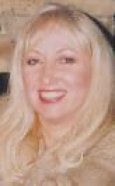
Catherine Whitney, portrait [8]
|
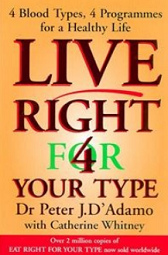
|
Book by Dr. Peter D'Adamo and Catherine
Whitney: 4 Blood Types, 4 Programs. Live Right 4
Your Type (cover) [9]
|
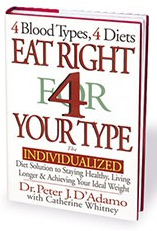
|
Book of Dr. Peter D'Adamo and Catherine
Whitney: 4 Blood Types, 4 Diets. Eat Right 4 Your
Type (cover) [10]
|
Dr. Peter D'Adamo about future developments
The challenge with intoxicated water and climate change are
huge for our immune system. Perhaps there will be a blood
group C which is resistant to it (4 Strategie, p.373).
Conclusion
A "mainstream" does not exist, but there are common sense,
health and Human Rights.
"USA" with their main stream food will suffocate by diabetes
and overweight as they will also suffocate with their
political lies.
Michael Palomino, November 2006







 The book of father James D'Adamo and Allan
Richards "One Man's Food" of 1980, cover [5]
The book of father James D'Adamo and Allan
Richards "One Man's Food" of 1980, cover [5]

